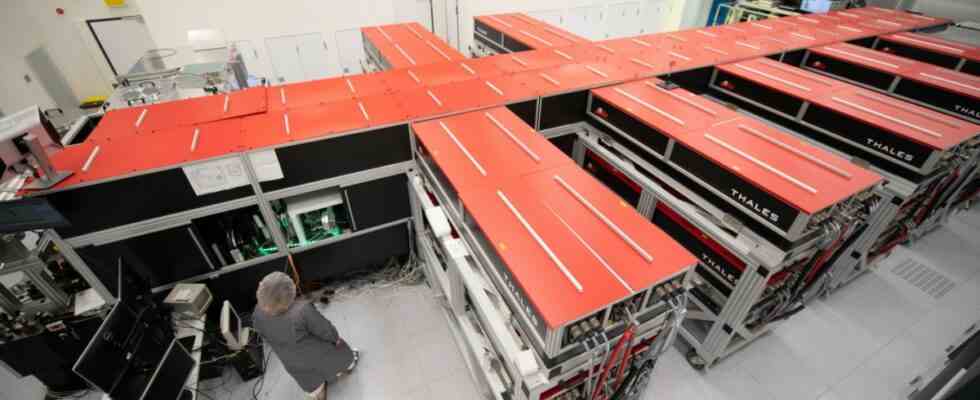The way the two obviously happy people are sitting next to each other with a bouquet of flowers on the table in front of them and paper and pen for the signatures is almost something of a wedding ceremony. How cameras and mobile phones are pulled out in front of them. And how later – as if it were the best man’s turn – two more people take a seat to also sign. In fact, however, in the Center for Advanced Laser Applications (Cala) on the Garching research campus, no marriages are celebrated and no washing machines are sold either, as Bernd Huber jokes while signing. Rather, the President of the Ludwig Maximilians University and the other signatories seal a cooperation between the LMU and the start-up Marvel Fusion, who want to work together in laser research in the future. The Free State of Bavaria appears as a kind of rich uncle, donating 2.5 million euros for this purpose.
The cooperation is a milestone for his company, says Moritz von der Linden, CEO of Marvel Fusion. The start-up is planning “decisive experiments” on the Cala’s high-intensity laser, which is one of the most powerful in the world, in order to get closer to its major goal – namely energy generation through laser-based nuclear fusion. Von der Linden is convinced that this could be “an important pillar in the energy supply of Europe and the world”. The head of the company, which was founded in 2019, announces in Garching that Marvel Fusion will build the first nuclear fusion power plants in ten years. “That’s realistic, and maybe we can do it a little faster.”
Marvel boss Moritz von der Linden (left) with Bavaria’s Science Minister Markus Blume on Thursday at the signing of the contract in Garching.
(Photo: Catherine Hess)
In the face of so much confidence, the thought of a quip popular with nuclear physicists comes to mind. It reads: Nuclear fusion is only 20 years away from being ready for the market – and has been for 60 years. In fact, the idea of merging two atomic nuclei based on the principle of the sun and generating energy from them is anything but new. Bavaria’s Minister of Science, Markus Blume (CSU), speaks in Garching of nuclear fusion as a “permanent promise to solve the major energy issues”. But unfortunately, according to Blume, “the progress was more visible on the time axis”. But this has changed: “The generation of energy with nuclear fusion was an abstract dream, now it can slowly become concrete hope,” says Blume. According to him, there are around 35 projects with new approaches worldwide, most of them in the USA – “but also one in Germany”.
The start-up wants to build the first nuclear fusion reactors in ten years at the latest
What is meant is the Munich company Marvel Fusion, which wants to help laser-based nuclear fusion achieve a breakthrough. Unlike most of its competitors, the company uses hydrogen and boron as fuel instead of deuterium and tritium. According to Moritz von der Linden, no radioactive waste is produced as a result; In addition, the energy density is extremely high – “we get a million times more energy from our fuel than from coal”. In Garching, too, the company boss raves about a “safe, CO₂-free and almost unlimited energy supply”. What he doesn’t go into are the many setbacks and disappointments in the past with the issue of nuclear fusion. Despite decades of research, the technology is still not usable for energy production. And many experts assume that nothing will change before 2050.
Moritz von der Linden, on the other hand, is confident that his start-up will be able to do this much earlier – and not just him. Marvel Fusion has raised 35 million euros in venture capital and is cooperating with companies such as Siemens and Trumpf. The head of the company estimates that around one billion euros will be needed to research the basic processes for laser-based nuclear fusion. The prototype of a power plant will then cost four to five billion euros. But all of this is still in the future. For the time being, further research work is pending – from now on also in Cala. LMU physicist Jörg Schreiber announces that its high-performance laser will be “improved in key areas” over the course of the five-year cooperation. In addition, the money from Freistaat and Marvel Fusion will be used to create more experimental chambers.
Atlas, one of the most powerful laser systems in the world, is at the center of research at Cala. With its help, the scientists in Garching not only conduct basic research in physics, but also work on medical applications – for example in the field of early detection and therapy of cancer tumors using laser-generated radiation.
The first results of the tests are to be presented as early as next year.
(Photo: Catherine Hess)
Marvel Fusion, in turn, needs Atlas’ powerful laser pulse to get the fusion reaction going. Moritz von der Linden has announced that the first results from the experiments in Cala will be presented as early as next year. According to his plan, the exact parameters for a power plant concept should be available in two to three years. “And that,” says the company boss, “is the starting signal for the development of a prototype.”

